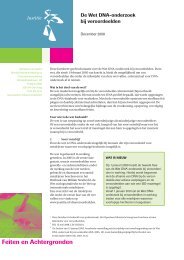INTERPOL HANDBOOK ON DNA DATA EXCHANGE AND PRACTICE
INTERPOL HANDBOOK ON DNA DATA EXCHANGE AND PRACTICE
INTERPOL HANDBOOK ON DNA DATA EXCHANGE AND PRACTICE
Create successful ePaper yourself
Turn your PDF publications into a flip-book with our unique Google optimized e-Paper software.
The most informative target loci for attempting to determine phylogenetic orbiogeographic origin are single nucleotide polymorphisms (or SNPs). SNPs can befound in areas of the genome that are subject to selective pressure, such as coding andregulatory regions. This means that they exhibit greater allele and genotype differencesbetween populations. Also, SNPs have a very low mutation rate meaning it is likely thatthe same or similar SNP genotype will be passed from one generation to the next.To date, the need to adhere to STR typing (due to the value of existing databases) andthe lack of individual diversity has delayed broad adoption of SNP technologies intoforensic science. However, the abundance of SNPs and progress in SNP genotypingtechnology will eventually ensure that forensic systems evolve to incorporate thesepolymorphisms. SNPs have been analyzed on the mt<strong>DNA</strong> and the Y chromosomefor some time 47 . Progress with autosomal SNPs suitable for forensic purposes wasforeshadowed in 2001 and large SNP multiplexes now exist for forensic identitytesting 48 .<strong>DNA</strong> markers that show an affiliation with population origin are often referred to asancestry informative markers (or AIMs). By using a panel of AIMs it is possible to inferthe biogeographical origin of an individual. Such <strong>DNA</strong>-based tools could be used earlyin an investigation, before suspects are identified, and would be highly advantageous tonarrow the pool of potential suspects. This would allow more efficient use of policeand forensic resources and objectively assist decision-making early in an investigation.There is also potential to use such techniques in large-scale victim identification cases,particularly in circumstances where there is no manifest of missing people and forensicanalysis is tasked with proposing possible explanations in the hope of leading ultimatelyto identification.An SNP-based technique for classifying ethnicity was reported in 2003 49 . Using a panelof 56 SNPs (mostly from pigmentation genes) it was reported that the test couldsuccessfully designate the ancestry of European, African and Asian donors with 99%,98% and 100% accuracy. Applying a reduced panel of the 15 most informative SNPs thelevel of accuracy reduced to 98%, 91% and 97%, respectively. This work representeda significant step towards the development of a <strong>DNA</strong>-based test for the inferenceof biogeographical ancestry and led to the development of a commercially availableproduct known as <strong>DNA</strong> Witness (<strong>DNA</strong> Print Genomics, Sarasota, FL). The mostrecent version of this product <strong>DNA</strong> Witness 2.5, includes subsidiary products EuroWitness 1.0 (a test that determines more specific geographic origins by providingrelative percentages of Northwest European, Southeast European, Middle Eastern orSouth Asian) and RETINOME (a test for iris colour).PAGE 80GEOGRAPHICAL SEARCH, PHYLOGENY, PHYSICAL CHARACTERISTICS<strong>AND</strong> OTHER USES







